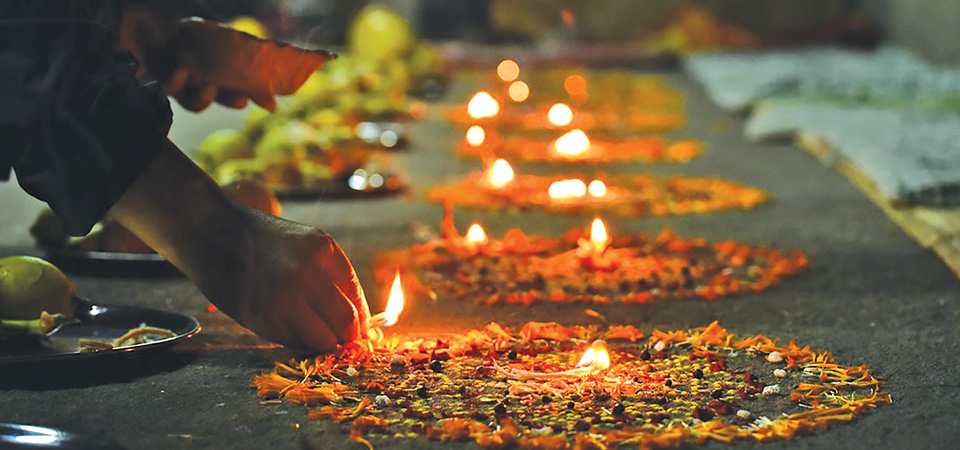Dhanashree: The unheard melody of Tihar

By Aashish Mishra
Kathmandu, Nov. 3:
Oh Lord Narayan!
He who resides in the hills and near the forests,
He who brings peace and tranquillity to the lives of people,
All hail Lord Narayan!
Hari Krishna Maharjan and his Dapha play this song every year after the end of Dashain to bid adieu to the autumn season.
“We start playing this song from the day of Kaulaga Paru, a day after Kojagrat Purnima, and continue till the day of Aamai, Laxmi Puja,” the 83-year-old resident of Balkumari, Lalitpur, informed.
Maharjan is by no means unique in doing this. For generations, Dapha groups – a musical tradition in the Newa community where singers and musicians perform devotional music based on classical raga and taal system – around the Kathmandu Valley have been singing this song or at least playing the tune this time of the year. Yet, very few know it. “People think we are playing the Malashree tune,” Maharjan said. “Hardly anyone outside of traditional music circles knows that there is an entirely different music played around the time of Tihar.”
This music, Maharjan explained, is the Dhanashree Tune.
Dhanashree takes its name from the ancient Dhanashree Raga it is based on. According to culture expert and social worker Subarna Shakya, it is not certain when the tune and the raga originated but it is an integral part of the classical music of the Indian subcontinent. The tune is also mentioned in the 13th century Sanskrit musicological text Sangita Ratnakar which means that it is at least 800 years old.
Although the tune is played in various parts of India too, the Dhanashree music played in Nepal is unique because it is still played in its original composition, informed composer and musical researcher Joogle Dangol.
“Over time, the Dhanashree tune in India morphed and changed but in Nepal, it remained the same,” Dangol explained. “For example, the modern Dhanashree Raga played in most parts of the Indian subcontinent does not touch the notes ‘Re’ and ‘Ga’ but the ancient one as can be heard in the Kathmandu Valley does.”
He added, “Unlike in India, the Nepali version also includes the major ‘Ga’ and major ‘Ni’ while ascending and the flat ‘Ga’ and flat ‘Ni’ while descending.”
The Dapha musical tradition of the Kathmandu Valley has preserved many classical tunes in their original form and Dhanashree is one of them, Dangol said.
He also shared that the tune is usually played with the Khin Baja, a classical membranophone, and on the flute. However, it can be played using modern musical instruments as well.
“Dhanashree is also a tune that is meant to be sung and there are various songs composed on it,” Dangol said. However, the song most closely associated with it is “Oh Lord Narayan!” culture expert Shakya informed.
Shakya also said that Dhanashree was one of the many tunes played by the Newa community to celebrate the seasons. “Every season has its own music in the Kathmandu Valley. Of them, the Dhanashree tune is the music of this particular time of year when the Tihar festival also falls. That is why the music is linked with Tihar just as Malashree is linked with Dashain,” he explained.
However, whereas Malashree is nationally prominent and is played and enjoyed by communities and ethnicities across the country, Dhanashree has not been able to gain the same level of fame. This is because the media has not given the same space to the latter tune as it has to the former, Dangol opined. “People know of the Malashree (Dangol believes that the Malashree tune is different from the melody we hear during Dashain which is the Malashee tune) because they hear it on radio and TV. They do not know Dhanashree because they do not hear it on their media,” he said.
Maharjan also believed the lack of popularity of Dhanashree was because of a lack of research. “Malashree has been extensively studied and is taught in music schools around the country. Dhanashree has not and is not.”
This worries Maharjan as he fears that the lack of documentation might eventually lead to the tune’s extinction. But for now, he and his communal band continue to play the Dhanashree, seeing off the autumn and welcoming Tihar, just like their forefathers before them and hopefully, their children after them, away from the spotlight and unrecognised by the ears of the larger public.
Recent News

Do not make expressions casting dout on election: EC
14 Apr, 2022
CM Bhatta says may New Year 2079 BS inspire positive thinking
14 Apr, 2022
Three new cases, 44 recoveries in 24 hours
14 Apr, 2022
689 climbers of 84 teams so far acquire permits for climbing various peaks this spring season
14 Apr, 2022
How the rising cost of living crisis is impacting Nepal
14 Apr, 2022
US military confirms an interstellar meteor collided with Earth
14 Apr, 2022
Valneva Covid vaccine approved for use in UK
14 Apr, 2022
Chair Prachanda highlights need of unity among Maoist, Communist forces
14 Apr, 2022
Ranbir Kapoor and Alia Bhatt: Bollywood toasts star couple on wedding
14 Apr, 2022
President Bhandari confers decorations (Photo Feature)
14 Apr, 2022










